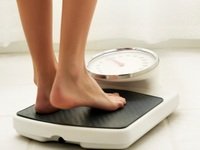How to Measure Your Weight?
 Standing on the scales is not going to be the only determiner of your weight. In fact, that only gives you a small portion of the picture and when you are trying to lose weight it can actually be aggravating to stand on the scales each day and weigh yourself.
Standing on the scales is not going to be the only determiner of your weight. In fact, that only gives you a small portion of the picture and when you are trying to lose weight it can actually be aggravating to stand on the scales each day and weigh yourself.Weight is a total measurement of your body, but there are many parts to your body including the fat you store and your muscles. Muscle mass weighs more than stored fat; if you have ever used weight lifting and exercise as your main means of losing weight then you might have become aggravated initially. You might have even seen your weight increase instead of decrease despite working out. This is because the stored fat is turned into muscle mass.
What you would have noticed if you kept going in your exercises such as weight lifting is that while your weight went up your clothes started fitting better. You will feel more toned because the fat is reduced.
Testing Body Weight
As you need to monitor your muscle mass and body fat changes you will need to know how to measure your weight and determine what your BMI is before you begin exercising. The BMI is called the body mass index. It is a measurement of the body fat based on two parameters: your weight and height. You also want to use BMI and weight measurements to test your hydration level as a means of ensuring you are not dehydrated after working out.You will need a set of scales that are properly calibrated. For the most accurate reading you will want to weigh yourself in private without any clothing or excess accoutrements like hair ties and jewelry. If you do not have a set of scales at home then just remove your shoes and all excess clothing.
For accurate results regarding reduction of body fat you should have a weighing routine. The morning is best because this is after a good night's rest, where you have not had anything to eat or drink. Always weigh yourself after emptying your bladder as this can be excess weight.If you cannot weigh yourself in the morning then make sure you weigh yourself each time with the same conditions such as after you work out or after you get off of work.
The Calculation for BMI
To reduce your body fat you will need to start off with a realistic number for your weight, your BMI, and a plan that will ensure proper weight loss. You can use the following formula to calculate your BMI: bodyweight in kilograms divided by height in meters squared. Take a look at the following table to see what BMI means:| BMI | Meaning |
|---|---|
| Less than 18.5 | Underweight |
| 18.5 – 24.9 | Normal weight |
| 25 – 29.9 | Overweight |
| 30 – 34.9 | Obesity level I |
| 35 – 39.9 | Obesity level II |
| More than 40 | Obesity level III |
The following pie graph shows estimated percentages of adults with BMIs within specific ranges:
It takes time to reduce your body fat, so you will need to monitor your progress overtime and luckily there is a calculator online to help you determine your current BMI.
BMI Calculator
The BMI for a normal weight is 18.5 to 24.9 so anything under or over that for an adult female and male is considered not normal. It does depend on age as a healthy teenage male of 18 can have a body fat percentage of 8% and still be considered as healthy.
Now take a look at your BMI. More than 25? This is considered overweight. Fortunately, there are solutions to reduce your body fat. But which method to choose? There are different techniques, each has pros and cons. You can check our convinient Weight Loss Calculator to estimate your weight loss.

